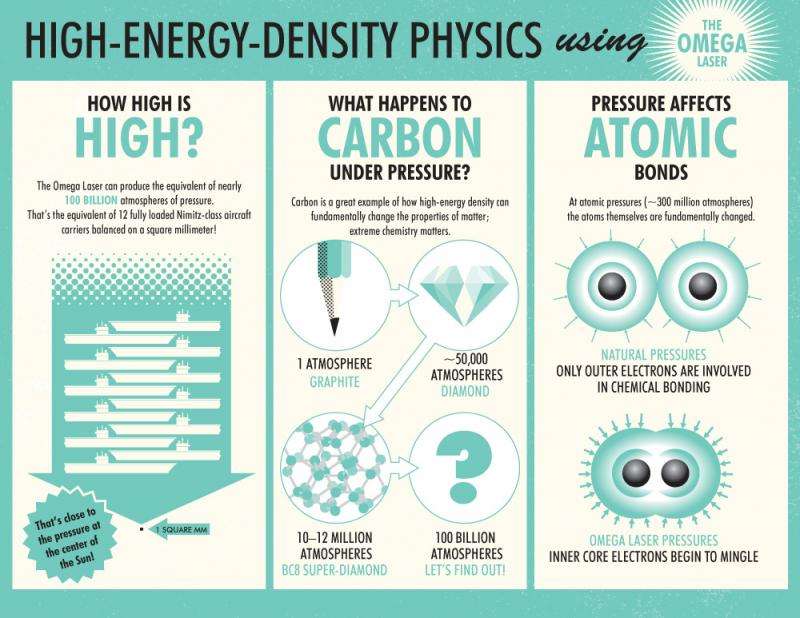New research initiative turns laser focus on high-energy-density physics

Atoms behave much differently when squeezed to pressures more than a million—or even a billion—times the atmospheric pressure on Earth. Understanding how atoms react under such high-pressure conditions can lead to the creation of new materials and give scientists valuable insights into the make-up of stars and planets, as well as the universe itself.
Those are among the reasons the University of Rochester has turned its attention to the relatively new field of high-energy-density physics. Another reason is that the University is well poised to make major contributions to the field.
"Our people and our resources put us in a unique position to gain crucial insights in the field of high-energy-density physics," says Provost and Senior Vice President for Research Rob Clark.
Rochester's Laboratory for Laser Energetics, for example, is home to the OMEGA laser. At 10 meters tall and 100 meters long, the OMEGA is the world's largest university-based laser.
Rochester has also recruited Gilbert "Rip" Collins to lead a new, multidisciplinary research initiative for high-energy-density physics. Collins was previously the director of Lawrence Livermore National Laboratory's Center for High-Energy-Density Physics, and is now professor in the Department of Mechanical Engineering and the Department of Physics and Astronomy, as well as senior scientist at the University's Laboratory for Laser Energetics. Collins says the initiative "will make it easier to collaborate between chemistry, engineering, physics, and astronomy," leading to faster advances in the field.
Collins studies, among other things, how atoms bond under conditions of extreme pressure. Typically, it's the outermost electrons of an atom that react with the electrons of other atoms. But when the pressure on the atoms is greatly increased, the inner electrons get involved, and that's when the fun begins.
"Under extreme pressure, the chemical properties of the elements that we're familiar with no longer apply," he says. "We need new periodic tables for different pressure conditions."
Diamond is one well-known material that forms under high pressure. Place carbon 100 miles deep into the earth—where the pressure is nearly 50,000 times greater than what exists on the earth's surface and the temperatures are above 2,000 degrees Fahrenheit—and the atoms become highly organized in a structure we call a diamond.
Yet that level of pressure is at the low end of the scale when it comes to high-energy-density physics. At more extreme pressures, such as two million atmospheres, sodium is converted into an insulator; at 10 million atmospheres, it's believed that hydrogen can be turned into a superconducting superfluid; and when pressures exceed 200 million atmospheres, it may be possible to make aluminum transparent.
The OMEGA laser allows researchers to achieve such pressures.
"Many people think of lasers as a source of intense heat," says Collins. "Lasers can also operate as a source of highly focused pressure, and the OMEGA laser allows us to study materials at pressures of millions to billions of atmospheres." Understanding how atoms behave under extreme pressures will enable researchers "to purposefully manipulate matter to form somewhat new, exotic materials," he adds.
Robert McCrory, vice president and director of the Laboratory for Laser Energetics, says Collins, who enjoys an international reputation, "is superbly fit to lead the effort at the University." He notes that facilities such as the laser lab, the National Ignition Facility at Lawrence Livermore, where Collins was employed before, as well as the Z machine at Sandia National Laboratories, "have opened the new high- energy-density physics frontier" and secured American leadership in the field.
But there's even more to high-energy-density physics than creating new materials. Michael Campbell, deputy director of the Laboratory for Laser Energetics, calls the field an "enduring science."
"There will always be new areas to explore, including the nature of the universe itself," he says. "The pressure at the center of planets exceeds millions of atmospheres and hundreds of billions for stars. High-energy-density physics can be key to helping us learn what planets and stars are made of, whether, like earth, they have magnetic fields, and how radiation and energy flow within our sun and other stars."
Provided by University of Rochester



















